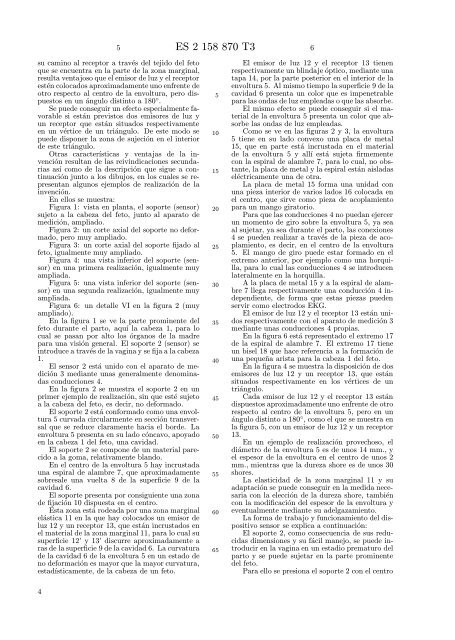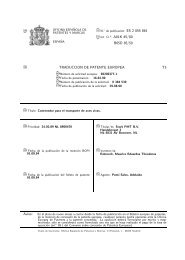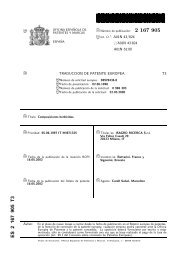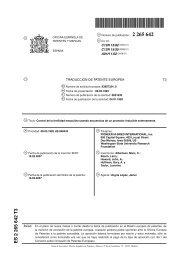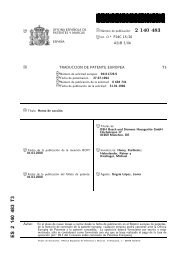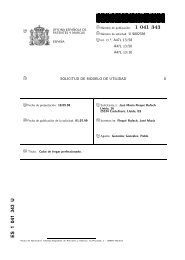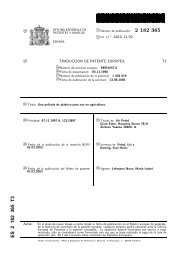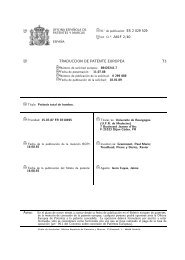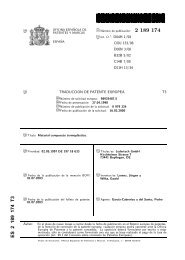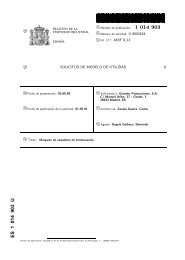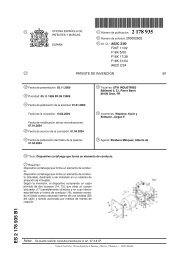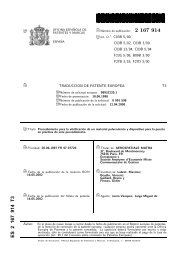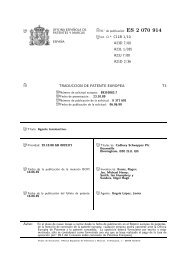dispositivo sensor para la medicion de parametros vitales de un feto ...
dispositivo sensor para la medicion de parametros vitales de un feto ...
dispositivo sensor para la medicion de parametros vitales de un feto ...
You also want an ePaper? Increase the reach of your titles
YUMPU automatically turns print PDFs into web optimized ePapers that Google loves.
5 ES 2 158 870 T3 6<br />
su camino al receptor a través <strong>de</strong>l tejido <strong>de</strong>l <strong>feto</strong><br />
que se encuentra en <strong>la</strong> parte <strong>de</strong> <strong>la</strong> zona marginal,<br />
resulta ventajoso que el emisor <strong>de</strong> luz y el receptor<br />
estén colocados aproximadamente <strong>un</strong>o enfrente <strong>de</strong><br />
otro respecto al centro <strong>de</strong> <strong>la</strong> envoltura, pero dispuestos<br />
en <strong>un</strong> ángulo distinto a 180 ◦ .<br />
Se pue<strong>de</strong> conseguir <strong>un</strong> efecto especialmente favorable<br />
si están previstos dos emisores <strong>de</strong> luz y<br />
<strong>un</strong> receptor que están situados respectivamente<br />
en <strong>un</strong> vértice <strong>de</strong> <strong>un</strong> triángulo. De este modo se<br />
pue<strong>de</strong> disponer <strong>la</strong> zona <strong>de</strong> sujeción en el interior<br />
<strong>de</strong> este triángulo.<br />
Otras características y ventajas <strong>de</strong> <strong>la</strong> invención<br />
resultan <strong>de</strong> <strong>la</strong>s reivindicaciones sec<strong>un</strong>darias<br />
así como <strong>de</strong> <strong>la</strong> <strong>de</strong>scripción que sigue a continuación<br />
j<strong>un</strong>to a los dibujos, en los cuales se representan<br />
alg<strong>un</strong>os ejemplos <strong>de</strong> realización <strong>de</strong> <strong>la</strong><br />
invención.<br />
En ellos se muestra:<br />
Figura 1: vista en p<strong>la</strong>nta, el soporte (<strong>sensor</strong>)<br />
sujeto a <strong>la</strong> cabeza <strong>de</strong>l <strong>feto</strong>, j<strong>un</strong>to al a<strong>para</strong>to <strong>de</strong><br />
medición, ampliado.<br />
Figura 2: <strong>un</strong> corte axial <strong>de</strong>l soporte no <strong>de</strong>formado,<br />
pero muy ampliado.<br />
Figura 3: <strong>un</strong> corte axial <strong>de</strong>l soporte fijado al<br />
<strong>feto</strong>, igualmente muy ampliado.<br />
Figura 4: <strong>un</strong>a vista inferior <strong>de</strong>l soporte (<strong>sensor</strong>)<br />
en <strong>un</strong>a primera realización, igualmente muy<br />
ampliada.<br />
Figura 5: <strong>un</strong>a vista inferior <strong>de</strong>l soporte (<strong>sensor</strong>)<br />
en <strong>un</strong>a seg<strong>un</strong>da realización, igualmente muy<br />
ampliada.<br />
Figura 6: <strong>un</strong> <strong>de</strong>talle VI en <strong>la</strong> figura 2 (muy<br />
ampliado).<br />
En <strong>la</strong> figura 1 se ve <strong>la</strong> parte prominente <strong>de</strong>l<br />
<strong>feto</strong> durante el parto, aquí <strong>la</strong> cabeza 1, <strong>para</strong> lo<br />
cual se pasan por alto los órganos <strong>de</strong> <strong>la</strong> madre<br />
<strong>para</strong> <strong>un</strong>a visión general. El soporte 2 (<strong>sensor</strong>) se<br />
introduce a través <strong>de</strong> <strong>la</strong> vagina y se fija a <strong>la</strong> cabeza<br />
1.<br />
El <strong>sensor</strong> 2 está <strong>un</strong>ido con el a<strong>para</strong>to <strong>de</strong> medición<br />
3 mediante <strong>un</strong>as generalmente <strong>de</strong>nominadas<br />
conducciones 4.<br />
En <strong>la</strong> figura 2 se muestra el soporte 2 en <strong>un</strong><br />
primer ejemplo <strong>de</strong> realización, sin que esté sujeto<br />
a <strong>la</strong> cabeza <strong>de</strong>l <strong>feto</strong>, es <strong>de</strong>cir, no <strong>de</strong>formado.<br />
El soporte 2 está conformado como <strong>un</strong>a envoltura<br />
5 curvada circu<strong>la</strong>rmente en sección transversal<br />
que se reduce c<strong>la</strong>ramente hacia el bor<strong>de</strong>. La<br />
envoltura 5 presenta en su <strong>la</strong>do cóncavo, apoyado<br />
en <strong>la</strong> cabeza 1 <strong>de</strong>l <strong>feto</strong>, <strong>un</strong>a cavidad.<br />
El soporte 2 se compone <strong>de</strong> <strong>un</strong> material parecido<br />
a <strong>la</strong> goma, re<strong>la</strong>tivamente b<strong>la</strong>ndo.<br />
En el centro <strong>de</strong> <strong>la</strong> envoltura 5 hay incrustada<br />
<strong>un</strong>a espiral <strong>de</strong> a<strong>la</strong>mbre 7, que aproximadamente<br />
sobresale <strong>un</strong>a vuelta 8 <strong>de</strong> <strong>la</strong> superficie 9 <strong>de</strong> <strong>la</strong><br />
cavidad 6.<br />
El soporte presenta por consiguiente <strong>un</strong>a zona<br />
<strong>de</strong> fijación 10 dispuesta en el centro.<br />
Esta zona está ro<strong>de</strong>ada por <strong>un</strong>a zona marginal<br />
elástica 11 en <strong>la</strong> que hay colocados <strong>un</strong> emisor <strong>de</strong><br />
luz 12 y <strong>un</strong> receptor 13, que están incrustados en<br />
el material <strong>de</strong> <strong>la</strong> zona marginal 11, <strong>para</strong> lo cual su<br />
superficie 12’ y 13’ discurre aproximadamente a<br />
ras <strong>de</strong> <strong>la</strong> superficie 9 <strong>de</strong> <strong>la</strong> cavidad 6. La curvatura<br />
<strong>de</strong> <strong>la</strong> cavidad 6 <strong>de</strong> <strong>la</strong> envoltura 5 en <strong>un</strong> estado <strong>de</strong><br />
no <strong>de</strong>formación es mayor que <strong>la</strong> mayor curvatura,<br />
estadísticamente, <strong>de</strong> <strong>la</strong> cabeza <strong>de</strong> <strong>un</strong> <strong>feto</strong>.<br />
5<br />
10<br />
15<br />
20<br />
25<br />
30<br />
35<br />
40<br />
45<br />
50<br />
55<br />
60<br />
65<br />
El emisor <strong>de</strong> luz 12 y el receptor 13 tienen<br />
respectivamente <strong>un</strong> blindaje óptico, mediante <strong>un</strong>a<br />
tapa 14, por <strong>la</strong> parte posterior en el interior <strong>de</strong> <strong>la</strong><br />
envoltura 5. Al mismo tiempo <strong>la</strong> superficie 9 <strong>de</strong> <strong>la</strong><br />
cavidad 6 presenta <strong>un</strong> color que es impenetrable<br />
<strong>para</strong> <strong>la</strong>s ondas <strong>de</strong> luz empleadas o que <strong>la</strong>s absorbe.<br />
El mismo efecto se pue<strong>de</strong> conseguir si el material<br />
<strong>de</strong> <strong>la</strong> envoltura 5 presenta <strong>un</strong> color que absorbe<br />
<strong>la</strong>s ondas <strong>de</strong> luz empleadas.<br />
Como se ve en <strong>la</strong>s figuras 2 y 3, <strong>la</strong> envoltura<br />
5 tiene en su <strong>la</strong>do convexo <strong>un</strong>a p<strong>la</strong>ca <strong>de</strong> metal<br />
15, que en parte está incrustada en el material<br />
<strong>de</strong> <strong>la</strong> envoltura 5 y allí está sujeta firmemente<br />
con <strong>la</strong> espiral <strong>de</strong> a<strong>la</strong>mbre 7, <strong>para</strong> lo cual, no obstante,<br />
<strong>la</strong> p<strong>la</strong>ca <strong>de</strong> metal y <strong>la</strong> espiral están ais<strong>la</strong>das<br />
eléctricamente <strong>un</strong>a <strong>de</strong> otra.<br />
La p<strong>la</strong>ca <strong>de</strong> metal 15 forma <strong>un</strong>a <strong>un</strong>idad con<br />
<strong>un</strong>a pieza interior <strong>de</strong> varios <strong>la</strong>dos 16 colocada en<br />
el centro, que sirve como pieza <strong>de</strong> acop<strong>la</strong>miento<br />
<strong>para</strong> <strong>un</strong> mango giratorio.<br />
Para que <strong>la</strong>s conducciones 4 no puedan ejercer<br />
<strong>un</strong> momento <strong>de</strong> giro sobre <strong>la</strong> envoltura 5, ya sea<br />
al sujetar, ya sea durante el parto, <strong>la</strong>s conexiones<br />
4 se pue<strong>de</strong>n realizar a través <strong>de</strong> <strong>la</strong> pieza <strong>de</strong> acop<strong>la</strong>miento,<br />
es <strong>de</strong>cir, en el centro <strong>de</strong> <strong>la</strong> envoltura<br />
5. El mango <strong>de</strong> giro pue<strong>de</strong> estar formado en el<br />
extremo anterior, por ejemplo como <strong>un</strong>a horquil<strong>la</strong>,<br />
<strong>para</strong> lo cual <strong>la</strong>s conducciones 4 se introducen<br />
<strong>la</strong>teralmente en <strong>la</strong> horquil<strong>la</strong>.<br />
A<strong>la</strong>p<strong>la</strong>ca<strong>de</strong>metal15ya<strong>la</strong>espiral<strong>de</strong>a<strong>la</strong>mbre<br />
7 llega respectivamente <strong>un</strong>a conducción 4 in<strong>de</strong>pendiente,<br />
<strong>de</strong> forma que estas piezas pue<strong>de</strong>n<br />
servir como electrodos EKG.<br />
El emisor <strong>de</strong> luz 12 y el receptor 13 están <strong>un</strong>idos<br />
respectivamente con el a<strong>para</strong>to <strong>de</strong> medición 3<br />
mediante <strong>un</strong>as conducciones 4 propias.<br />
En <strong>la</strong> figura 6 está representado el extremo 17<br />
<strong>de</strong> <strong>la</strong> espiral <strong>de</strong> a<strong>la</strong>mbre 7. El extremo 17 tiene<br />
<strong>un</strong> bisel 18 que hace referencia a <strong>la</strong> formación <strong>de</strong><br />
<strong>un</strong>a pequeña arista <strong>para</strong> <strong>la</strong> cabeza 1 <strong>de</strong>l <strong>feto</strong>.<br />
En <strong>la</strong> figura 4 se muestra <strong>la</strong> disposición <strong>de</strong> dos<br />
emisores <strong>de</strong> luz 12 y <strong>un</strong> receptor 13, que están<br />
situados respectivamente en los vértices <strong>de</strong> <strong>un</strong><br />
triángulo.<br />
Cada emisor <strong>de</strong> luz 12 y el receptor 13 están<br />
dispuestos aproximadamente <strong>un</strong>o enfrente <strong>de</strong> otro<br />
respecto al centro <strong>de</strong> <strong>la</strong> envoltura 5, pero en <strong>un</strong><br />
ángulo distinto a 180 ◦ ,comoelquesemuestraen<br />
<strong>la</strong> figura 5, con <strong>un</strong> emisor <strong>de</strong> luz 12 y <strong>un</strong> receptor<br />
13.<br />
En <strong>un</strong> ejemplo <strong>de</strong> realización provechoso, el<br />
diámetro <strong>de</strong> <strong>la</strong> envoltura 5 es <strong>de</strong> <strong>un</strong>os 14 mm., y<br />
el espesor <strong>de</strong> <strong>la</strong> envoltura en el centro <strong>de</strong> <strong>un</strong>os 2<br />
mm., mientras que <strong>la</strong> dureza shore es <strong>de</strong> <strong>un</strong>os 30<br />
shores.<br />
La e<strong>la</strong>sticidad <strong>de</strong> <strong>la</strong> zona marginal 11 y su<br />
adaptación se pue<strong>de</strong> conseguir en <strong>la</strong> medida necesaria<br />
con <strong>la</strong> elección <strong>de</strong> <strong>la</strong> dureza shore, también<br />
con <strong>la</strong> modificación <strong>de</strong>l espesor <strong>de</strong> <strong>la</strong> envoltura y<br />
eventualmente mediante su a<strong>de</strong>lgazamiento.<br />
La forma <strong>de</strong> trabajo y f<strong>un</strong>cionamiento <strong>de</strong>l <strong>dispositivo</strong><br />
<strong>sensor</strong> se explica a continuación:<br />
El soporte 2, como consecuencia <strong>de</strong> sus reducidas<br />
dimensiones y su fácil manejo, se pue<strong>de</strong> introducir<br />
en <strong>la</strong> vagina en <strong>un</strong> estadio prematuro <strong>de</strong>l<br />
parto y se pue<strong>de</strong> sujetar en <strong>la</strong> parte prominente<br />
<strong>de</strong>l <strong>feto</strong>.<br />
Para ello se presiona el soporte 2 con el centro<br />
4


